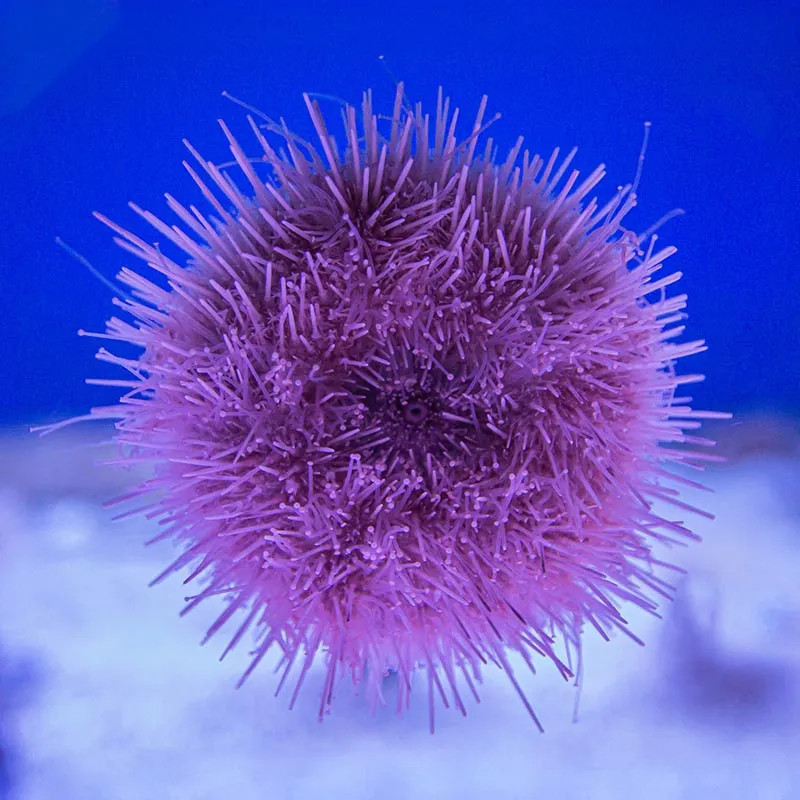Stocks Available
Purple Pin Cushion Short Spine Urchin
SKU:223033
Pseudoboletia sp
Medium

Stock Available
Introduction: • Species: Purple Short Fin Sea Urchin • Common Names: Purple Sea Urchin, Short Fin Sea Urchin • Natural Habitat: Commonly found in shallow waters of rocky reefs and coastal regions in temperate and tropical seas. Physical Characteristics: • Appearance: Round body covered in short, purple spines that give it a distinct and vibrant appearance. The spines are used for movement, protection, and feeding. • Size: Typically grows up to 2-4 inches (5-10 cm) in diameter. • Lifespan: Can live 15-30 years in the wild, though their lifespan in captivity may be shorter depending on care. Habitat Requirements: • Tank Size: Requires a minimum of 30 gallons, with a mature, stable marine environment that includes plenty of rock surfaces. • Water Conditions: o Temperature: 72-78°F (22-25°C). o pH: 8.1-8.4. o Salinity: 1.023-1.025 specific gravity. • Aquascaping: Provide ample rocky surfaces for grazing, and ensure secure tank decorations to prevent the urchin from moving them. Diet: • Primary Diet: Herbivorous; feeds on various types of algae, including macroalgae and biofilm on live rock. • Supplemental Feeding: In the absence of sufficient algae, offer dried seaweed or algae wafers to meet its dietary needs. • Feeding Frequency: Ensure a consistent food source by monitoring algae growth or supplementing regularly. Compatibility: • Temperament: Peaceful and slow-moving, making it a suitable addition to a community reef tank. • Suitable Tank Mates: Safe with most peaceful fish, corals, and invertebrates, but avoid species that may prey on sea urchins, such as large crabs or predatory fish. • Incompatibilities: Not compatible with aggressive fish or invertebrates that may damage or harm the urchin's spines. Care Level: • Difficulty: Moderate; requires stable water conditions and a mature tank with sufficient algae growth. Sensitive to sudden changes in water quality and salinity. • Health Monitoring: Regularly monitor the health of the urchin by observing spine condition and movement. Lack of movement or spine loss may indicate stress or poor health. Breeding: • Breeding in Captivity: Rarely bred in home aquariums due to complex reproduction requirements. • Spawning: In the wild, they reproduce through external fertilization, with eggs and sperm released into the water column. Economic Considerations: • Market Demand: Popular among reef tank enthusiasts for algae control and their unique appearance. • Pricing: Generally affordable and widely available through marine pet suppliers. Sustainability and Conservation: • Wild Population: Some species of sea urchins are over-harvested in certain regions, but most populations remain stable. • Aquaculture Efforts: Limited captive breeding efforts exist, though many sea urchins in the trade are wild-caught. • Conservation: Look for sustainably sourced specimens to reduce environmental impact. Conclusion: The Purple Short Fin Sea Urchin is a visually striking and beneficial addition to reef aquariums, known for its role in algae control. While it requires a stable marine environment with ample food sources, it can thrive and contribute to the overall health and beauty of the aquarium with proper care.
Data sheet
4 other products in the same category:
Customers who bought this product also bought: